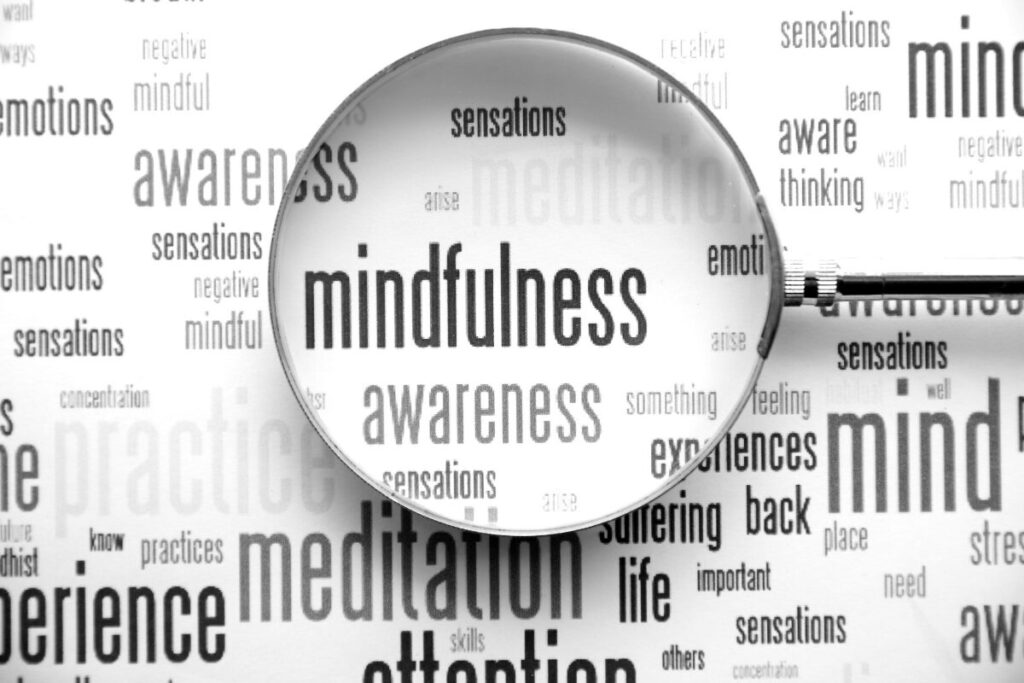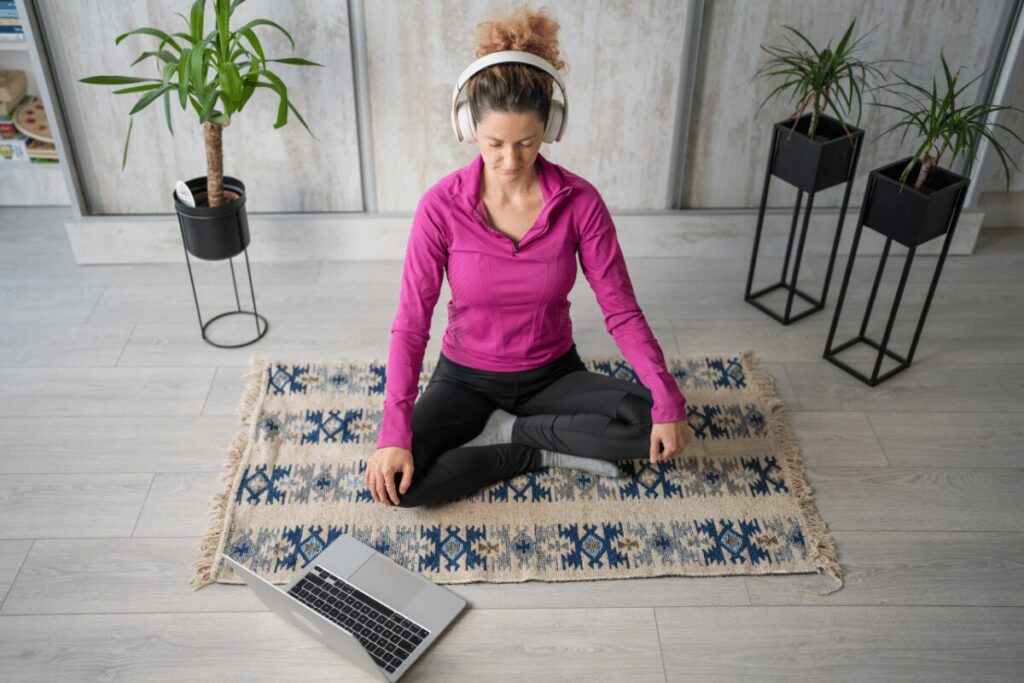Your Uncontrolled Mind Fuels Stress and Anxiety
Feeling like you have no control over your emotions can be frustrating. When your mind is racing, and you’re constantly having uncontrollable thoughts, it can feel overwhelming. At some point in our lives, we’ve all experienced these feelings, whether from overthinking something or worrying about something else. These heavy feelings of negativity can easily lead to chronic stress and anxiety.

That feeling of negativity does not have to consume you; there is hope – you have more power over your mind than you probably realize. This control can be gained by making small changes to your daily habits. By this, I mean your actions are intentional, and it’s these intentional actions that can help to calm down the cycle of mental turmoil and guide you to cultivating inner peace.
We will look at simple techniques like mindfulness meditation, conscious breathing, regular exercises, and even spending time in nature. Everyday life can become a cruel balancing act between survival and success. We forget that self-care is the fundamental fuel for our mental existence. You can control your thoughts by committing to yourself and promising to be consistent with your commitment. A sense of balance, stillness, and clarity is attainable, and this beautiful act will ultimately lead to you having a more peaceful and fulfilling life.

I will give you ten practical habits that can easily and almost effortlessly be added to your daily routine to help you overcome those racing thoughts, find calmness, and conquer stress and anxiety. Improving your mental and physical well-being will, in turn, make it easier for you to handle life’s challenges..
Let’s look at them now.
10 Simple Habits
Table of Contents
1. Practice Mindfulness Meditation
Mindfulness meditation is a popular practice that has gained a lot of attention recently due to its numerous benefits. It is one of the most effective habits for quieting a noisy mind and reducing stress levels. Mindful meditation involves focusing on and accepting the present moment without any judgment.

If you’re new to the practice of mindful meditation, the following five steps will help you get started and guide you through the basic process.
- Find a comfortable place to sit. With all forms of meditation, your environment must be conducive to the emotional state you are trying to obtain; tranquility brings tranquility. Begin your meditation by closing your eyes and focusing your attention on a fixed point within your mind, bringing your attention inward.
- Focus on your breathing. With your focus turned inward, begin to connect with your breathing. Take a slow, deep breath in and slowly exhale, paying attention to the sensation of each breath, the rise and fall of your abdomen, or the feeling of the air you are breathing. Allow your breath to flow naturally without trying to control it. Whenever your mind wanders, gently bring your focus back to the breathing.
- Embrace the present moment and bring your focus from breathing to your body. As your body begins to naturally relax into a calm breathing pattern, thoughts, and emotions or physical sensations will surface. This is okay and expected; you want to acknowledge and observe them without judgment. Calmly bring your focus back to your breathing.
- Take this moment to cultivate compassion and kindness toward yourself and others. As you acknowledge and observe your thoughts and sensations, also allow yourself to understand that it is normal for your mind to wander and for distractions to occur. At this moment, you want to avoid belittling yourself or giving into a loss of control; instead, gently guide your mind back to the present moment by refocusing on your breath. Allow your breathing to be your anchor in a moment of conflict.
- When you have returned to a calm state of focus and feel ready to end your meditation, slowly bring your awareness back to your surroundings. Leave a tranquil state and return to your tranquil environment.

Mindfulness meditation is a practice that you will develop over time. It is a beautiful art you can have with you at any time and can utilize to calm and refocus your thoughts and emotions. Practicing 5-10 minutes, twice a day, can work wonders for your resolve.
Tip: Set a regular time to meditate daily, like first thing in the morning or before bed. Apps like Calm, Headspace, and Insight Timer can guide you.
2. Practice Deep Breathing Exercises
When you notice stress building, stop what you’re doing and take several deep breaths. Breathing deeply for a minute or two calms the body and quiets the mind.

Here’s a helpful breathing exercise to follow whenever you feel anxious or overwhelmed. Begin by taking a slow inhale through your nose for 4 counts, holding your breath for 2 counts, and then exhaling slowly through your mouth for 6 counts. Keep repeating this exercise for a few minutes to feel calm and relaxed.
Tip: Make a habit of taking mindful breath breaks throughout your day. This simple practice brings you back to a calm state quickly.
3. Replace Negative Thoughts with Positive Affirmations
The inner voice in your head wields great power over your outlook and moods. When negative self-talk arises, quickly counter it by replacing it with a positive affirmation.

For example:
- Instead of saying, “I’m useless at my job.”
- Replace with, “I have unique strengths and talents I contribute.”
- Instead of saying, “I’m such a failure.”
- Replace with, “I’m still learning. I don’t give up on myself.”
With consistent practice, negative mind chatter happens less often, while your inner voice becomes kinder.
Tip: List your favorite positive affirmations and review them when you notice negativity creeping in.
4. Spend Time in Nature
Did you know spending time in nature significantly reduces stress? Next time you feel anxious or overwhelmed, make it a point to get outdoors.

Go for a walk through the park, find a quiet spot to sit by the water, or hang out in your backyard listening to the birds. Tune into nature’s sights, sounds, and smells to calm your mind.
If you can’t get outside, bring elements of nature indoors. Display fresh flowers and plants, diffuse essential oils like lavender, and open windows to let in sunlight and fresh air.
Tip: Keep inspirational nature photos on your phone or computer desktop for quick mental breaks.
5. Practice Guided Visualization
Visualization techniques leverage your imagination to cultivate desired feelings like inner calm.

Guided imagery scripts prompt you to picture soothing scenes in your mind’s eye – like rolling waves on the beach or a quiet forest path. As you vividly imagine the scene’s details, feelings of contentment naturally arise.
Set aside 10 minutes daily to practice with recordings from apps or YouTube. This habit strengthens your ability to detach from anxious thoughts and sink into a relaxed state at will.
Tip: Make visualization part of your bedtime routine to wind down for sleep.
6. Avoid Multitasking
In our fast-paced culture, multitasking has become ubiquitous. We scroll social media during meetings, text friends while watching Netflix, and drive while on phone calls.

But constantly splitting your attention drains your mental resources. It increases errors, diminishes productivity, and spurs stress.
Make it a priority to focus on one task at a time. Close extra browser tabs to avoid distractions when you’re in a meeting. While driving, set aside your phone to give the road your full attention.
Single-tasking not only improves efficiency and accuracy but also enables calm focus. The next time you feel frazzled, pause and do just one thing mindfully.
Tip: Schedule activities that require deep focus during your energy peak times when you’re less prone to distractions.
7. Keep a Gratitude Journal

Taking a few minutes each day to actively appreciate the good things around you has incredible benefits, including reduced stress and increased positivity.
Develop a routine of keeping a gratitude journal. Each morning or night, jot down 5-10 things you feel grateful for – your cozy bed, morning coffee, friends who make you laugh, favorite memories, etc.
Taking time to tune into positive aspects of your life boosts your overall outlook, happiness, and resilience to stress.
Tip: Review your previous journal entries on days when you need perspective. All you have to be grateful for is right there on the pages.
8. Unplug from Technology
While devices provide a lot of convenience, they also provide information overload, distraction, and unnecessary stress for many people.

Make it a priority to regularly unplug by setting tech-free times in your day. For example:
- Take a break from your phone for an hour after work to relax.
- Turn off screens at least one hour before bedtime to unwind and prepare for rest.
- Initiate a “no phone zone” policy during weekend breakfasts or family dinners.
Being informed regarding technology use enables greater focus, presence, and calm.
Tip: Disable distracting notifications, like social media alerts, during working hours. Schedule set times to catch up on apps.
9. Get Moving with Exercise
Along with physical health benefits, regular exercise delivers powerful stress-relieving, mood-boosting effects.

When you feel yourself getting anxious, it’s important to find ways to release that nervous energy. One of the best ways to do this is by getting up and moving your body. You could go for a brisk 10-minute walk around your neighborhood or spend 20 minutes doing vigorous cleaning or yard work.
Physical activity can help you feel calm and centered when you feel anxious by releasing tension and clearing your mind.
Aim for at least 30 minutes daily, combining cardio, strength training, and stretching. Maintaining an exercise habit prevents stress from accumulating in your mind and body.
Tip: Avoid overdoing high-intensity workouts when extremely anxious, as it can worsen symptoms. Moderate movement is best.
10. Stick to a Consistent Bedtime
Prioritizing sleep is key for mastering your mind and keeping stress in check. Unfortunately, late-night TV or getting stuck on devices often leads to sacrificing rest.

For a couple weeks, observe when you naturally feel sleepy. Then, set a bedtime 30 minutes earlier to allow time for winding down. Stick to it, even on weekends.
Dim the lights, avoid digital stimulation, read, and take a hot shower – whatever helps prepare your body and mind for sleep. Getting quality rest leaves you feeling calmer and better able to manage challenges.
Tip: Let your close contacts know your new bedtime so they don’t disrupt your evening wind-down time.
When to Seek Professional Help

While the habits in this article can help manage day-to-day stress and anxiety, it’s important to acknowledge that serious mental health conditions may require more support.
If you find your anxiety or worry is excessive, uncontrollable, or interfering with your ability to function and enjoy life, seek help from a mental health professional. A good therapist can provide tools to help you cope with distress that these everyday habits alone cannot relieve.
Likewise, if stress and negative thinking ever lead to suicidal thoughts or intent, call emergency services or the National Suicide Prevention Lifeline at 988 immediately.
We can all help prevent suicide. The 988 Lifeline provides 24/7, free, and confidential support for people in distress, prevention and crisis resources for you or your loved ones, and best practices for professionals in the United States.
Talk or Text, Call

Don’t hesitate to get expert care for mental health challenges that feel beyond your ability to manage solo. With compassionate professional guidance tailored to your unique needs, relief from persistent anxiety is possible.
Start Mastering Your Mind Today
Learning to master your mind takes commitment, but the payoff in reduced anxiety and increased inner peace is immense. Start applying one tip today, then gradually incorporate others into your routine.

By consistently practicing these habits, you can gain control of your mind, overcome negative thought patterns, and create a calm focus. Keep going; with time and consistency, these skills will become natural.
You have the power to master your mind! What’s one habit you’re excited to start working on today?
Live Your Life & Love It!
I STRONGLY WANT TO REITERATE: While the habits in this article can help manage day-to-day stress and anxiety, it’s important to acknowledge that serious mental health conditions may require more support. Don’t hesitate to get expert care for mental health challenges that feel beyond your ability to manage solo. With compassionate professional guidance tailored to your unique needs, relief from persistent anxiety is possible. 988 Suicide & Crisis Lifeline
Related Article: Master Your Mind: A Beginner’s Guide to Transcendental Meditation
FAQs
How is stress related to anxiety?
Stress and anxiety often go hand-in-hand. When you’re stressed, it can make you feel anxious. And when you’re anxious, it creates stress in your mind and body. Stress and anxiety can feed into each other.
How do you release stress from your body?
Exercising, deep breathing, relaxing baths, getting massages, meditating, and doing yoga are great ways to release stress that builds up in your body. Finding healthy outlets helps let it go.
How can I stop stress and anxiety?
Developing daily habits like mindfulness meditation, limiting technology use, keeping a gratitude journal, and getting enough sleep can help minimize daily stress and anxiety. But if symptoms are severe, seeing a therapist may be needed.
Why can’t I handle stress?
It’s important to recognize that everyone has different thresholds for handling stress. If you feel overwhelmed by circumstances that others take in stride, don’t belittle yourself. Instead, focus on finding coping strategies that work for you, and don’t hesitate to ask for help.
How do you deal with extreme stress?
When stress feels extreme, take a step back and prioritize self-care. Spend time outdoors, connect with supportive friends, get professional counseling, and look into anti-anxiety techniques. Take your time with it when things feel unmanageable, and don’t try to go at it alone; seek help.
During the writing process, Grammarly generated responses to the following AI prompts:
Prompts created by Grammarly
– “Create an outline”
– “Make it more descriptive”
– “Improve it”
Prompts I wrote
– “rephrase”
– “rephrase it”
Legal Disclaimer
The information provided in this article titled “Master Your Mind: 10 Simple Habits To Conquer Stress And Anxiety” is for educational and informational purposes only. The content is not intended to be a substitute for professional medical advice, diagnosis, or treatment. Always seek the advice of your physician or qualified mental health provider with any questions you may have regarding a medical condition or mental health disorder.
The author and publisher of this article do not assume any responsibility for any personal injury, mental health issue, or damage to property resulting from the use or misuse of the information provided herein. Reliance on any information this article provides is solely at your own risk.
The author is not rendering professional advice or services to the individual reader. This article recommends seeking immediate professional help if you experience suicidal thoughts. The National Suicide Prevention Lifeline can be reached at 988. The authors and publisher disclaim any liability arising directly or indirectly from the use of the information contained in this article.
The strategies, techniques, and habits outlined in this article may not be suitable for everyone. Individual results may vary, and it is important to consult with a qualified professional before implementing any lifestyle changes, especially if you have pre-existing medical conditions or mental health concerns.
Furthermore, while efforts have been made to ensure the accuracy and completeness of the information presented in this article, neither the author nor the publisher makes any representations or warranties of any kind, express or implied, about the completeness, accuracy, reliability, suitability, or availability with respect to the content contained herein.
In no event shall the author or publisher be liable for any loss, injury, claim, liability, or damage arising from the use of or reliance on any information provided in this article, whether directly or indirectly.
You acknowledge and agree to these terms and conditions by reading this article. If you do not agree with these terms, you should refrain from accessing or using any information provided herein.









